M. Isidora Forrest's Blog, page 47
December 14, 2013
What is Isis’ Connection with the Throne?
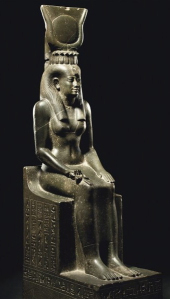
Isis seated upon the symbol of Her name
The symbol of the throne has an intimate connection with Isis because “Throne” is the meaning of Her name. The Great Goddess Isis is the Great Goddess Throne. Many Egyptologists explain this by saying that Isis was originally the personification of the royal throne.
It is certainly true that Isis was associated with the kingship—as were all the major Deities and most of the minor ones. The living king, seen as the embodiment of the God Horus, was considered the son of Isis (and of many other Goddesses). After death, the king became an Osiris so naturally Isis became his mourning widow. As the personification of the royal throne, Isis is the institution of the kingship itself. If we seek a feminist interpretation, we could rightly say that no king could take his place on the throne unless he had a close relationship with the Goddess Throne. To rule, the king must sit in the lap of the Goddess as Her child and husband.
Yet for me, this explanation of the origin of the Goddess Who is the greatest Goddess of Egypt—and arguably the greatest Goddess of all time—is bloodless and boring. And it is a vast understatement of the true meaning of the Throne.
As many readers know, Isis is the Greek version of the Goddess’ name. In Egyptian, She is Iset (Eset; Aset; Auset). One of the meanings of iset is throne. More generally, it means seat. The ancient Egyptians seemed to have had a flexible, idiomatic use for the word similar to its use in English. For example, when we say “he is in the seat of power,” we are not often referring to an actual seat, but mean that he is in charge. Similarly, iset smeter means judgment seat and the term referred to a tribunal of judges. Just as we say we have our heart set (a word that comes from seat) on something, the Egyptian wished for her iset ib—literally the seat of the heart—but meaning her heart’s desire.

Isis wearing the symbol of Her name on Her head
Even more generally, iset means place. Judging by the uses of it we have left to us, it often means an important or sacred place. Iset Weret is the Great Place, an idiom for Heaven. The iset wabet is the place of purity; that is, the sanctuary. Iset Mayet (Maat) is the place of law or truth; the Otherworld. Iset neferet is the beautiful place; the cemetery. Iset hotep is the place of peace; the tomb. Temples can be designated as isets, as the special places of the Deities. The Iset en Neit is the Temple of Neith. The Iset Heqit is the Place of the Frog Goddess, Heqit.
Egyptologists believe that the gathering of people around the shrines of Deities played an important part in the early organization of Egyptian society. This is confirmed by the fact that one of the earliest Egyptian words for a settlement was seat or abode—and that it especially referred to the seat or abode of a Deity. Iset as place is also distinctly feminine. In hieroglyphs, one of the determinatives used to indicate cities (the seat or place of the Deity) is an egg. The same determinative is used to indicate both Goddesses and women in general.
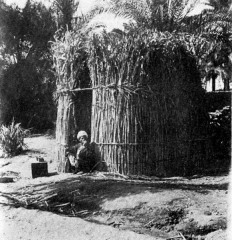
This image, from the Oriental Institute, University of Chicago, is of a reed and mud hut, perhaps the type that would have been built around an Iset of a Deity in an early Egyptian period.
So an iset is feminine and it is a seat, an abode, a chamber, a tomb, a room, a place. Iset is location, a point in the circle, a crossing of the x, y, and z axes. Iset is somewhere. It is, in fact, the Primal Somewhere, the First Somewhere—and even the First Something. In the Coffin Texts, the androgynous Creator Deity Atum refers to the primordial state as the time “when my throne had not yet been put together that I might sit upon it.” Atum says S/He was “alone with Nu in lassitude, and I could find no place on which to stand or sit.” So before the coming together of the Throne, there was nothing but the Nu, nothing but the Primal Chaos, the Unformed, the Non-Being. But with the coming of the Throne, the universe begins to unfold. There is no longer nothing. Something exists and it is the Throne. Where before there was Non-Being, now there is Being Given Form, Being provided with a seat upon which to rest its Becoming, a point for all things to gather around. The Throne—Iset—is the Form of Being and the Place of Becoming.
We can connect this primordial Iset with one of the most ancient forms of Goddess known to humankind; because for human beings, the Place of Being can be none other than the Earth. Therefore She Who is the Sacred Place must also be the Earth. She is the Great Mother Earth Who gives birth, bringing all things into existence. An Egyptian text—supposedly enormously ancient—also has something to tell us about the relationship between the Iset and the Earth. Pharaoh Shabaku (25th dynasty) thought this text so important that he preserved it by having it carved in stone. It explains how the God Ptah created the universe, how the Great Throne of Ptah provides sustenance for Egypt, and how Osiris, the Grain God, was drowned at Memphis, the city of Ptah (and a city that later became strongly connected with Isis and Osiris and with Isis and Serapis).
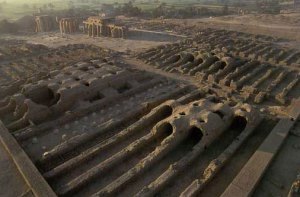
The granaries at the Ramesseum; photo by Patrick Godeau from Tour Egypt site
The text explains that the Great Throne is also called the Seat of All Life and the Lady of All Life because She provides Egypt with food. In this case, “Great Throne” probably refers to the sacred city of Memphis. If so, it is another example of Place being both personified and feminine. In addition, we are told that Memphis is known as the Granary of Ptah because Osiris was drowned there. Like the grain fields during the annual flood, Osiris, the Grain God, is drowned at the feet of the Great Throne, the Sacred Granary.
Here “Great Throne” does not specifically refer to Isis, the wife of Osiris. However, I believe that this myth could be a remnant from a time when the Great Goddess Throne was one and the same as the Great Earth Mother, the Goddess of the Place. She is the Goddess Who sustains the people by the grain that grows upon Her body and which She contains like a granary. Perhaps it is all that remains of the more ancient ascendancy of Iset, the Universal Goddess Throne, of Whom Iset, the wife of Osiris, is just one aspect.
Filed under: Goddess Isis, Modern Paganism Tagged: Ancient Egypt, Aset, Coffin Text, Deities, Egypt, Egyptian, Goddess Isis, Iset Aset, Isis, Isis Magic, Isis Throne,







December 7, 2013
Isis, Horus, and the Holy Day of December 25th
Hello, Isiopolites!
Re-run day today as I am working all weekend at my company’s annual Warehouse Sale…happy people buying sharp objects. Thought you might enjoy reading how Horus’ birth became associated with Dec 25.
It doesn’t take much of an internet search to discover the “fact” that the Goddess Isis bore the Holy Child Horus on December 25th. Frequently, the statement is used to dismiss the Christian tradition of the birth of the Christ on that day (and by inference, Christian tradition in general) as “mere Pagan superstition.” Frankly, this has been driving me a little crazy for years—for a variety of reasons.
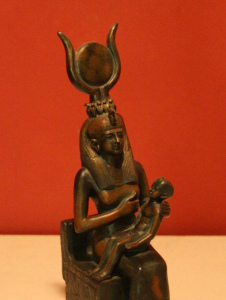
The Holy Mother & Her Holy Child
First, there is absolutely nothing wrong with celebrating the birth of Jesus Christ, the bringer of the light of Christianity to its believers, at that time of year when the light of the sun begins its return to the world. It is the perfect symbol and early Christians would have been silly to ignore it.
The other thing that bothered me was that I thought that the December 25th date was stretching the truth to make a point; the point being that the “real meaning of Christmas” was, in fact, the celebration of a Pagan Deity. Why—when there are so very many legitimate connections between the Deities of all the world’s pantheons—should we have to distort the truth to make that point? (Please see my previous posts, Mary Christmas and Happy Easter for some of those Isiac-Christian connections.)
Well, it finally bothered me enough that I decided to find out where that whole Horus-born-on-December-25th thing came from.
I first checked in with my pal Plutarch since I know he mentions a couple of Egyptian winter solstice traditions—and since Horus-born-on-the-25th seemed likely to have been a late Pagan tradition. Writing in the late 1st and early 2nd centuries CE, Plutarch tells us that Harpocrates (from Hor-pa-khered, Horus the Child) is born on the winter solstice (I quote it here at length because I like the lead-in):
Thus we shall attack the many boring people who find pleasure in associating the activities of these gods with the seasonal changes of the atmosphere or with the growths, sowing, and plowing of crops, and who say that Osiris is being buried when the corn is sown and hidden in the earth, and that he lives again and reappears when it begins to sprout. For this reason it is said that Isis, when she was aware of her being pregnant, put on a protective amulet on the sixth day of Phaophi, and at the winter solstice gave birth to Harpocrates, imperfect and prematurely born, amid plants that burgeoned and sprouted before their season . . . and they are said to celebrate the days of her confinement after the spring equinox. (Plutarch, On Isis and Osiris, 65B-c)
Since Horus is a solar God, His birth at the winter solstice—even to the extent that He is “imperfect and prematurely born” at that time—makes symbolic sense. This tradition was still going strong by the 4th and 5th centuries CE, for another writer, Macrobius, famous for his book about the Saturnalia, notes that:
…at the winter solstice, the sun would seem to be a little child like that which the Egyptians bring forth from a shrine on the apponted day, since the day is then at its shortest and the god is accordingly shown as a tiny infant. (Macrobius, Saturnalia, 1.18:10
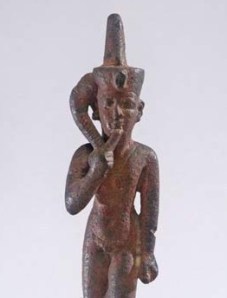
Harpocrates with His finger to His mouth in a childish gesture later interpreted as an admonition to silence
So this was an Egyptian tradition at least from the time of Plutarch. But was it so earlier? Well, I’m still looking into that. (Please see the Addendum at the end of this post.) But at least one author has noted that in the time of Pharaoh Amenemhet I (approx. 1991-1962 BCE), the pharaoh took a new title as the sun approached winter solstice in the 17th year of his reign. The title was Nem-mestu, Repeater of Births, a title also given to the dead and which may refer to daily solar rebirth or even to reincarnation. In addition to the normal pharaoh-sun connection, the king is even more strongly associating himself with the sun by taking the title, and it would seen from the timing that he is particularly associating himself with the winter solstice sun. At the very least, this points to the importance of the winter solstice to Egyptian tradition.
Just as there are today, there were other winter holy days around the time of the winter solstice. You’re probably familiar with the Roman Saturnalia (Greek Kronia) which took place from December 17th through the 23rd (at its most developed stage). It was a carnivalesque festival with plenty of partying and gift-giving on the last day, just a day or two from the astronomical solstice. The 4th century CE Christian polemicist, Epiphanius, notes two very interesting Pagan festivals that took place “on the very night of Epiphany,” which is Epiphanius’ preferred date for the birth of the Christos. He grouches that “many places deceitfully celebrate a very great festival on the very night of the Epiphany, to deceive the idolaters who believe them into hoping in the imposture and not seeking the truth.” (Epiphanius, Panarion, 22,8) Of the celebration in Alexandria, he writes:
First, at Alexandria, in the Koreum, as they call it; it is a very large temple, the shrine of Kore. They stay up all night singing hymns to the idol with a flute accompaniment. And when they have concluded their nightlong vigil, torchbearers descend into an underground shrine after cockcrow and bring up a wooden image which is seated naked on a litter. It has a sign of the cross inlaid with gold on its forehead, two other such signs, one on each hand and two other signs, one actually on each of its two knees—altogether five signs with a gold impress. And they carry the image itself seven times around the innermost shrine with flutes, tambourines and hymns, hold a feast, and take it back down to its place underground. And when you ask them what this mystery means, they reply that today, at this hour Kore—that is, the Virgin—gave birth to Aion. (Epiphanius, Panarion, 22,9)
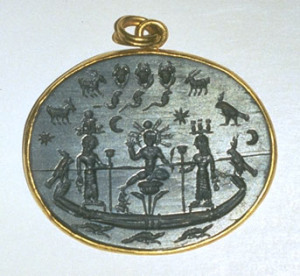
On this protective amulet, Isis & Nephthys guard the shining solar child, Horus.
Some scholars believe that the Alexandrian Virgin was Isis (some ancient Egyptian Hymns call Isis “virgin;” in the Hermetic text, Kore Kosmou, Isis is likely the “Cosmic Virgin” of the title) and that the “crosses” on Her limbs may have been ankhs. Could be, but doesn’t have to be; Alexandria was, after all, a polytheistic city. Epiphanius goes on to mention other identical and, in his mind, deceitful festivals in Petra and in Elusa celebrating the birth of the “only son of the Lord” of a Virgin Goddess. In Petra, the Holy Child is Dusares, an Arabian God identified with Dionysos, Who was, in turn, identified with Helios, the sun. (Epiphanius, Panarion, 22,11)
Okay, so we have the solar Holy Child’s birth at or around the winter solstice. Makes perfect sense. But what about that December 25th date?
Well, you see, the Roman calendar went through a certain amount of upheaval and—bottom line—December 25th was considered the “traditional” date of the winter solstice, even if that was off from astronomical solstice. (If you want to calendar geek on that, check this out or this.) We have from a number of sources, including Epiphanius, that “the eighth before the Kalends of January” was considered to be the winter solstice. (Epiphanius, Panarion, 22,3) Because of the inclusive way the Romans counted, this “eighth before the Kalends” was December 25th.
What’s more, the early Christians who chose that date, chose it precisely because it was the winter solstice and was connected to the return of the light. In a work attributed, perhaps falsely, to the 4th century Christian church father John Chrysostom, the writer connects the birth of Jesus with the birth of Sol Invictus, the Unconquerable Sun, which was celebrated on Rome’s traditional winter solstice, December 25th:
But Our Lord, too, is born in the month of December . . . the eighth before the calends of January [25 December] . . ., But they call it the “Birthday of the Unconquered.” Who indeed is so unconquered as Our Lord? Or, if they say that it is the birthday of the sun, He is the Sun of Justice. (Chrysostom, De Solstitia et Aequinoctia Conceptionis et Nativitatis Nostri Iesu Christi et Iohannis Baptistae; “On the conceptions and births of our Jesus Christ and John the Baptist on the solstices and equinoxes.”)
Another interesting thing about the choice of December 25th is that—even just those few days after the astronomical solstice—you can begin to see that the light is indeed returning. Some scholars have suggested that the December 25th date for the solstice reflects this perceivable change, so that even though the exact moment of astronomical solstice is prior to the 25th, it becomes noticeable about the 25th.
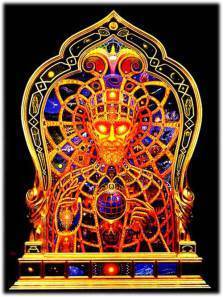
Artist Alex Grey’s mesmerizing Cosmic Christ; now we’re talking Gods!
So there we have it. There actually IS reason to connect the winter solstice birth date of Isis’ Holy Child, Horus, with the traditional December 25th birth date of Mary’s Holy Child, Jesus. Yet, I don’t think early Christians “stole” the date from Horus (or any of the other solar Gods Who always were and always will be born on the winter solstice). Nor do I think the fact that the date has Pagan antecedents means Christianity was built on a lie or in any way denigrates Christianity, nor should we think that Christians merely copied their religion from the Pagans around them. For early Christians, as for ancient Egyptians—and indeed for both ancient and modern worlds—the return of the light at winter solstice is at once an uplifting environmental fact and a hopeful spiritual symbol.
And so I wish you all Many Happy Returns of the Light on this holy day of December 25th.
Addendum: I’ve reviewed my materials and confirmed that, yes—as you might expect from a sun-focused culture—the winter solstice was quite important in Egyptian culture and religion. There are plenty of inscriptions and texts to support that, and a number of temples and monuments are oriented toward the winter solstice sunrise, especially those dedicated to Re-Hor-Akhty, Re-Horus of the Horizon.
Filed under: Goddess Isis, Modern Paganism Tagged: Alexandria, Birthday of Horus, Christianity, Christmas, Goddess Isis, Helios, Horus, Isis, Isis & Chrisitanity, Isis Magic, Jesus, Osiris








December 4, 2013
The Magic of Isis in Daughters of the Nile
Enjoy!
========================= FORMATTED RELEASE ====================
From critically acclaimed historical fantasy author, Stephanie Dray comes the long-awaited new tale based on the true story of Cleopatra’s daughter.
After years of abuse as the emperor’s captive in Rome, Cleopatra Selene has found a safe harbor. No longer the pitiful orphaned daughter of the despised Egyptian Whore, the twenty year old is now the most powerful queen in the empire, ruling over the kingdom of Mauretania—an exotic land of enchanting possibility where she intends to revive her dynasty. With her husband, King Juba II and the magic of Isis that is her birthright, Selene brings prosperity and peace to a kingdom thirsty for both. But when Augustus Caesar jealously demands that Selene’s children be given over to him to be fostered in Rome, she’s drawn back into the web of imperial plots and intrigues that she vowed to leave behind. Determined and resourceful, Selene must shield her loved ones from the emperor’s wrath, all while vying with ruthless rivals like King Herod. Can she find a way to overcome the threat to her marriage, her kingdom, her family, and her faith? Or will she be the last of her line?
Read the Reviews
“A stirring story of a proud, beautiful, intelligent woman whom a 21st century reader can empathize with. Dray’s crisp, lush prose brings Selene and her world to life.” ~RT Book Reviews
“The boldest, and most brilliant story arc Dray has penned…” ~Modge Podge Reviews
“If you love historical fiction and magical realism, these books are for you.” ~A Bookish Affair
Read an Excerpt
Below me, six black Egyptian cobras dance on their tails, swaying. I watch their scaled hoods spread wide like the uraeus on the crown of Egypt. Even from this height, I’m paralyzed by the sight of the asps, their forked tongues flickering out between deadly fangs. I don’t notice that I’m gripping the balustrade until my knuckles have gone white, all my effort concentrated upon not swooning and falling to my death.
And I would swoon if I were not so filled with rage. Someone has arranged for this. Someone who knows what haunts me. Someone who wants to send me a message and make this occasion a moment of dread. My husband, the king must know it, for he calls down, “That’s enough. We’ve seen enough of the snake charmer!”
There is commotion below, some upset at having displeased us. Then Chryssa hisses, “Who could think it a good idea to honor the daughter of Cleopatra by coaxing asps from baskets of figs?”
The story the world tells of my mother’s suicide is that she cheated the emperor of his conquest by plunging her hand into a basket where a venomous serpent lay in wait. A legend only, some say, for the serpent was never found. But I was there. I brought her that basket. She was the one bitten but the poison lingers in my blood to this day. I can still remember the scent of figs in my nostrils, lush and sweet. The dark god Anubis was embroidered into the woven reeds of the basket, the weight of death heavy in my arms. I can still see my mother reach her hand into that basket, surrendering her life so that her children might go on without her. And I have gone on without her.
I have survived too much to be terrorized by the emperor’s agents or whoever else is responsible for this.
If it is a message, a warning from my enemies, I have already allowed them too much of a victory by showing any reaction at all. So I adopt as serene a mask as possible. My daughter blinks her big blue eyes, seeing past my facade. “Are you frightened, Mother? They cannot bite us from there. The snakes are very far away.”
I get my legs under me, bitterness on my tongue. “Oh, but they’re never far enough away.”
###
Available now in print and e-book!
Amazon | Barnes & Noble | iTunes | Kobo | Powells | IndieBound | Goodreads
STEPHANIE DRAY is a bestselling, multi-published, award-winning author of historical women’s fiction and fantasy set in the ancient world. Her critically acclaimed historical series about Cleopatra’s daughter has been translated into more than six different languages, was nominated for a RITA Award and won the Golden Leaf. Her focus on Ptolemaic Egypt and Augustan Age Rome has given her a unique perspective on the consequences of Egypt’s ancient clash with Rome, both in terms of the still-extant tensions between East and West as well as the worldwide decline of female-oriented religion. Before she wrote novels, Stephanie was a lawyer, a game designer, and a teacher. Now she uses the transformative power of magic realism to illuminate the stories of women in history and inspire the young women of today. She remains fascinated by all things Roman or Egyptian and has-to the consternation of her devoted husband-collected a house full of cats and ancient artifacts.
Filed under: Goddess Isis








December 1, 2013
Why Does Isis Have Wings?
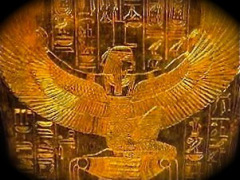
Isis spreads Her protective wings
Or perhaps it would be more accurate to ask why images of Isis have wings. As a Goddess, Isis takes whatever form She likes, of course. So the question is, what do the wings mean to us that makes them important in images of Her?
The first and easiest answer is that Isis is a Bird Goddess. Her most important sacred animal is a bird of prey. The Goddess often takes the form of Her sacred raptor; the kestrel (the most common falcon in Egypt) or the black kite.

The powerful Black Kite, the sacred raptor of Isis
In Egyptian art, when Isis and Nephthys are not shown as women, They are shown in full bird-form or sometimes as woman-headed kites or kestrels sitting or hovering by the bier of Osiris. As birds, Isis and Nephthys mourn Osiris, screeching Their shrill bird cries to express Their sorrow. Even quite late, Isis and Nephthys were shown with wings attached to Their arms—which is the way we are most used to seeing Isis’ wings portrayed—or wearing a garment of stylized wings that wrap gracefully around Their bodies.
Kites were connected with funeral customs from at least the beginning of the Old Kingdom, if not earlier. Texts speak of a woman called The Kite who was the Pharaoh’s chief female funerary attendant. She was supposed to remove poisons from the deceased, magically purifying him.
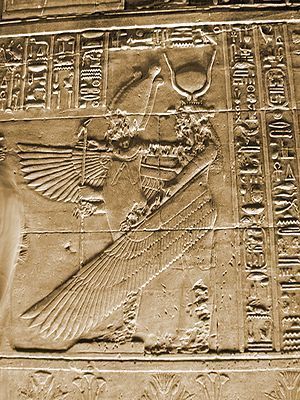
Isis protecting Osiris with Her wings
Soon there are two Kites—specifically identified as Isis and Nephthys in the Pyramid Texts. The Kites not only lamented and purified Osiris, but also were responsible for ferrying Him to the Otherworld. It is not until the New Kingdom that we find illustrations of Isis and Nephthys as kestrels.
Black kites are fairly large, dark-plumed birds that feed on both live prey and scavenge for carrion. They are sociable, intelligent, and aggressive birds—and would even attack wounded human beings. It may have been the bird’s fierceness that inspired one of the earliest Pharaohs to take the name Kite.
Isis is fierce in protecting Osiris. And both Sisters are fierce in Their lamentations for the God. The black kite’s cry—a shrill, plaintive, screeching—may have sounded to the ancient Egyptians like wailing, lamenting women. It may have been that the ancients saw a correspondence between the kite’s scavenging for carrion and Isis’s scavenging for the scattered pieces of Her husband Osiris’ body in order to assemble them for renewal. Or perhaps in the cleverness of the black kite the Egyptians saw a reflection of the cleverness of the Goddess Isis as She tricked the enemy Set time and again.
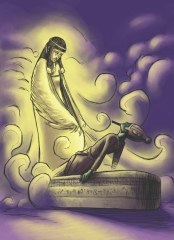
Isis fans life into Osiris with Her wings
On a magical level, Isis’ wings are the means by which She fans renewed life into Osiris. They are the protection spread out over the deceased in the tomb. Their shadow is our shelter in this life and the next. For human beings, wings have always exerted a strong fascination and engendered intense longing. We are in awe of the ability of winged creatures to fly under their own power. Even today when flight is available through mechanical means, many, many people still have “the flying dream.” In the dream, we fly on our own, our arms held out to our sides like huge wings, soaring like great, wild birds. Yet beyond physical flight, wings also commonly symbolize spiritual flight—ascent to the Heavens. And since feelings of rising, floating, or flying upwards can accompany spiritual experience, it is quite natural for cultures throughout the world to conceive of spirit beings—from angels to faeries—as winged.
In Egypt, a very ancient conception of the cosmos envisioned the Heavens as the enormous wings of the great falcon God Horus. These heavenly wings, attached to the disk of the Sun, were a common Egyptian protective motif. In fact, the image of the winged disk of Egypt was so powerful that other peoples, such as the Babylonians and the Hittites, adopted it. Some scholars believe that the beautiful Hebrew biblical phrase “the sun of righteousness shall arise with healing in his wings” may have been inspired by the Egyptian symbol of the winged solar disk.

I love the flying dream!
This protective aspect of the symbol of wings was key in Egyptian thought; so almost invariably, when you see the open wings of a Deity, the wings are intended to protect—and Isis is the protective Goddess par excellence.
[image error]
Isis mourning with “to fold the wings” gesture
Furthermore, the Egyptian word for “to fold the wings,” sekhen, also means to embrace. An Egyptian mourning posture mimicked the protective embrace of Osiris by Isis. And surely, it was Isis’ protecting, enfolding, winged arms that the Egyptian mother had in mind when she recited this protective charm for her child: “My arms are over this child—the arms of Isis are over him, as she put her arms over her son Horus.” Nevertheless, the wings of Isis could also be aggressive, one text tells us that Isis “struck with Her wing” and closed the mouth of a river.
The open wings of Isis can also be related to a posture seen in images of the ancient Egyptian Bird Goddess. This is the posture of the famous Neolithic statuette of a so-called dancing woman with her arms raised in an open curve above her head, and which has become a popular amulet among modern Goddess worshippers. The same posture can be seen in the Goddess figures that ride in the curved boats that were a favorite theme of pre-dynastic Egyptian pottery and petroglyphs.
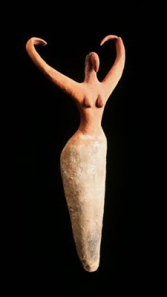
Perhaps a priestess of the Bird Goddess with her arms raised to indicate wings.
According to Egyptologist Louis Breasted, the posture is typical of Egypt. And although these ancient figures do not have obvious wings, their unwinged but upraised arms foreshadow the winged, upraised arms of Goddesses seen in later Egyptian art. These beak-faced figures are often identified as Bird Goddesses, so perhaps the wings are implied—or they may indicate that the figures represent human priestesses who are imitating their Bird Goddess. Whatever the case, the “wing” stance is a posture of great antiquity and numenosity and many researchers consider it to be characteristic of the Divine Feminine.
If you wish to experiment with the power of Isis’ wings for yourself, try The Wings & Breath of Isis on page 268 of the new edition of Isis Magic.
Filed under: Goddess Isis, Modern Paganism Tagged: Black kite, Egypt, Egyptian myth, Flying dream, Goddess, Goddess Isis, Goddess worship, Horus, Isis, Isis brings life, Isis Magic, Nephthys, Osiris, Why does Isis have wings?, Wings of Isis








November 24, 2013
Isis, Women & Magic in Antiquity

The astral light!
We are just starting a semester on the incredibly broad topic of “Magic” at Hermetic Society here in Portland. I’m up in December, so I’ve been thinking about and researching the topic lately.
With a subject like magic, one of the first things you have to do is define what you mean by “magic.” One of my personal definitions is, “magic is what happens when we DO religion.” This works for me because I tend to consider all my spiritual practices as magical. You’ve no doubt heard a number of others, such as Crowley’s famous statement that magick (with a k for him) is “the Science and Art of causing change to occur in conformity with will.”
[image error]
Mr. Crowley in full ritual gear. “Who said you could take my picture?”
Or Dion Fortune’s version in which consciousness is changed in conformity with will. Starhawk, in The Spiral Dance, defines it as “the art of sensing and shaping the subtle, unseen forces that flow through the world, of awakening deeper levels of consciousness beyond the rational” and emphasizes that magic is natural, not supernatural. The ancient Egyptians would have agreed on the naturalness of magic. Magic or heka is considered an essential energy of the universe, is in all things, and is meant to be used by us. (Right there with ya on that one, sisters and brothers!)
For the purposes of this post today, in which I want to touch on how women in ancient Egypt interacted with Isis for magical purposes, I’d like to narrow the discussion to practical magic, that is, magic intended to have an actual effect in the actual world. I was reminded of another term for this type of practical magic from the introduction to Ancient Christian Magic by Marvin Meyer and Richard Smith. They argue for discarding the term “magic” because of its many negative connotations in favor of the more neutral “ritual power.” This applies pretty well to practical magic, the type of magic Meyer and Smith were studying. In practical magic, we almost invariably engage in some type of ritual that is intended to invoke power that is, in turn, directed toward an end.
[image error]
Ancient Christian Magic by Meyer & Smith; well worth having a copy if you like the magical papyri
I’m also reading a dissertation by Meghan McGinnis on this topic. Her focus is late antiquity, which is the period from which we have the most records of personal magic, including the Magical Papyri as well as literary references to magic, which may or may not be based in fact. In late antiquity, magic has a more ambiguous reputation—even in Egypt—than it did in earlier Egyptian society. When it came to women, things were even more complicated because magic used by women was seen as sneakier than magic used by men. This is, of course, bullshit; but that sort of thing was in the atmosphere and stayed in the atmosphere there and elsewhere for a very long time. And it still persists. Hence female magic users are often described as “witches” (in the negative sense) while men are often described “mages” or “priests.”
For women in ancient Egypt, practical magic might be undertaken for fertility, healing, love, and business…fairly typical human concerns, though the fertility topic tended to land more heavily in female laps for the obvious reasons.
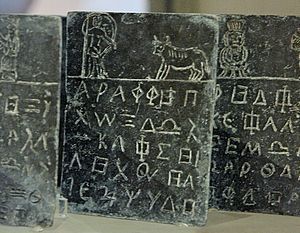
Magical book formed of seven pages enclosed by a cover with a veiled woman’s head and a bearded man. Lead, 4th–5th centuries AD. Origin unknown. (Photo credit: Wikipedia)
Interestingly, in Egypt, it seems that use of practical magic among men and women was less “gendered” than it was in much of the rest of the magical world. Let’s take the example of love magic. According to McGinnis, in much of the world, you’ll find women using persuasive, seductive magic on men, but men using demanding, binding magic on women. In Egypt, you’ll find the same spell used for men or women. An example is the “Isis Love Spell” in which the text tells how to use the same spell for women or men. It says, “say these things on behalf of women” (that is, when doing the spell for a woman on a man). It continues, “But when [you are speaking] about women (on behalf of a man) then speak conversely so as to arouse the females after the males.”
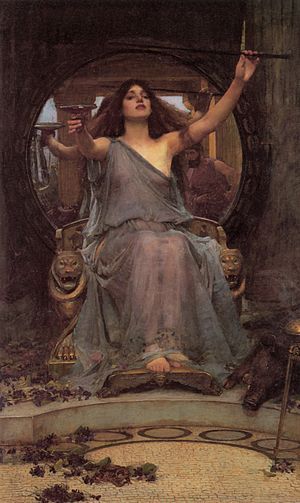
Circe Offering the Cup to Odysseus. Oldham Art Gallery, Oldham, U.K. (Photo credit: Wikipedia) What I love about this painting is that the sorceress is enthroned; very Isis-like way to wield magic!
In Egypt, the same applied in cursing magic and protective magic, though it seems to have been women’s responsibility to magically protect the children. Health and healing were the place where things diverged given the differing health concerns of women, including both fertility and contraception. Here we often find Isis being called upon to heal. One of my favorites is this one for healing inflammation of the uterus:
Write it [this formula] on a piece of silver when the moon is waning, and repeat it while you pour warm sea water [over it], utter the name [the magical names in the formula] Perform it very well. Do this for 44 days.
“I invoke you, great Isis, ruling in the perfect blackness, mistress of the gods of heaven from birth, Atherneklesia Athernebouni Labisachthi Chomochoochi Isi Souse Mounte Tntoreo Iobast Bastai Ribat Chribat Oeresibat Chamarei Churithibath Souere Thartha Thabaaththa Thath Bathath Lathai Achra Abathai Ae. Make the womb of ….attain the condition from god and be without inflammation, without danger, always without pain, now [say this] two times, at once, [say this] two times!”
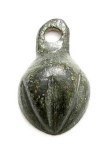
This isn’t a Coptic vulva stone, but a Roman vulva amulet.
The incomprehensible words in the center of this formula are magical names. Most likely they are divine names and epithets that were corrupted by scribal error and/or misunderstanding over the many years that the formulae were copied and recopied. As unknown magical words, they gain their own kind of power. I personally LOVE these magical words from the papyri.
Women also wore amulets to keep their uteruses safe and healthy, including the famous Knot of Isis and an obscure amulet called a “vulva stone” mentioned in the Coptic medical texts, but of which we know little.
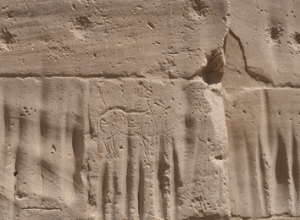
The marks of fingernails at the Temple of Isis at Philae
Women also made pilgrimage to sacred sites to help them conceive. At Isis’ temple at Philae, some pillars have grooves worn in the stone as women raked their fingernails on the stone to scrape bits of it away so that they could take it with them, possibly to ingest as a fertility potion.
I’m not aware of any spells that ask Isis to do harm, as some spells invoking other Underworld Goddesses do. However, we do find curses in which the curser asks that “the sacred rites of Isis that mean peace be turned against him;” a more passive-aggressive way of cursing.
And of course there were Isis formulae for divination—by direct vision, by dream, and by a method using palm leaves and the letters of the Coptic alphabet, probably similar to tarot cards in that each letter would have a specific meaning.
After looking at practical magic from a gender perspective, I am pleased to see that magic seems to have been an equal opportunity affair, with the exception that women were more concerned with fertility, women’s health issues, and the protection of children—at least in Egypt. Use of magic seems to have crossed socio-economic lines as well with both the poorest of the poor and wealthy businesswomen using it to further their aims. We know royal women used it, too; witness the famous “harem conspiracy” of dynastic times in one of the royal women used it to promote her son’s kingship.
Magic continued to be used by women and men even after Egypt was Christianized. From an earlier period, we know there were female magical specialists such as “the wise woman.” This title continued to be used in the late period and some of these wise women turn up in the literature as the enemies of various Christian monastics. Clerics speak against “hags who sing charms.” And we have the Late Antique comment of one rabbi that, “all women must be sorceresses.” And so it begins…

Woohooo, witchy woman! But note the dustpan, turns out she’s actually a servant girl.
Filed under: Goddess Isis








November 16, 2013
Who is Isis?
Not what Her myths say about Her; not what history says.
Who is Isis when we experience Her?
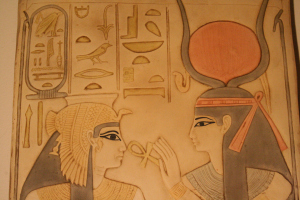
Let me breathe the breath of Isis. Let Her take my hand.
Most of us would start by describing a relationship. She’s like a mother, a sister, a lover, a teacher. Since that’s the way we relate to the people in our lives, it makes sense that we would relate to Divine personalities in the same way. The models for relationship with which we have to work are the ones we’ve used all our lives, the human ones. And this approach works quite well, too. The second half of Isis Magic is about just that—creating and deepening a real relationship with Her.
I have been comforted by the motherly wings of Isis. I have argued with Her like a sister. I have been crazy for Her like a lover. I have bowed to Her will as to a queen. (In fact, a very interesting and worthwhile devotional exercise is to interact with Her in relationships like these—a different type of relationship each day for a week.)
But we must also remember that although Isis can relate to us in ways similar to human beings, Isis isn’t human. She’s a Goddess. She is Goddess. And that adds a whole new dimension to how we experience Her—and to Who and What we might think She is. Perhaps we can call this the priestessly or priestly relationship, the philosophical relationship, or the mystical relationship.
Answering the question of Who Isis is means trying to figure out what we think the Divine is and Who we think the Deities are (or Deity is, if that’s your preference). I have found the Qabalistic concept of the Four Worlds very helpful in trying to sort all this out. Hermetic Qabalah, along with a solid dose of NeoPlatonism and ancient Egyptian theology—to the extent that we can deduce it—form the backbone of my own understanding of the unmanifest and Divine realms. (Yes, yes. I know it’s eclectic. I’m NeoPagan. That’s what we do.)
In the simplest terms—not that I think you need simple terms, mind you; I do—the Qabalah posits four layers or levels of existence, which proceed from a unity at the highest level and become increasingly multiple with each successive stage. Yet all the levels remain connected and interpenetrating. Here in the manifest universe, we have diversity. Diverse plants, animals, people—and Deities. The next level up (or in, or out, if you prefer) is also very diverse, but it’s the first of the unmanifest realms. For lack of a better term, we can call it the astral or lower astral. In Qabalah, this level is the “treasure house of images” and it contains, among many other things, spiritual images—thoughtforms, Godforms, Goddessforms—from all the pantheons of the world. In our regular interactions with the Divine, this is most likely the level in which we’re working. When I talk to Isis and She answers me in words and images, this is probably where we’re connecting.
A great example of this comes from a now-defunct TV show called Dead Like Me. (Bear with me, here.) It’s about a group of grim reapers whose job is to take human souls out of their bodies just before they die—and to send the soul to the next life. In the first season, we always got to see the souls as they walked into the afterlife—and each vision reflected the person’s individual belief about what “heaven” should be. The Buddhist was greeted by a meditating Buddha, the Christian by Christ, a child by a wonderful amusement park. That’s kinda my picture of what happens, too—at least during that first transition after death. Thus all religious traditions are true; if you’re picturing a purgatory, you’re probably going to find one. If you’re picturing a journey through the underworld with Re, you’re probably going to get it.
(On a side note, this is why I recommend having a death dream; by visualizing your transition in advance, you build up your own specific images in the treasure house of images so they’ll be there for you when your time comes.)
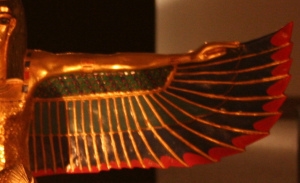
Keep me, Isis, in the shadow of Your wings.
The next level is less diverse, more concentrated. We can think of it as the archetypal realm. Here, humankind’s multiplicity of Deities are great, but less diverse, currents of Divine energy. The Great Mother, over here. The Warrior God, over there. The Teacher of Wisdom, two streams down. This is the source of the numinosity that lies behind and empowers the many names and faces of the Divine found in the world’s many spiritual traditions. As a Great Goddess, the energy of Isis flows into our world through many (even most) of these channels, but we are always free to choose whatever current particularly resonates with us. Some people connect with Her most readily as the Divine Mother, others are awed by Isis, Great of Magic, yet others discover Her in all Her aspects.
The next level is the Unity, the singular source of the multiple streams of Divine energy that populate the archetypal realm. Here, Isis is The Only One—as indeed the Egyptians called Her. Of course, if you were approaching from a different stream, Yahweh or Odin or Allah or Amun or Inanna would be The Only One. The Egyptians understood this; there were a number of Deities they called The Only One. (Not all of Them though, this seems to have been a particular title of the Great Goddesses and Gods.)
This ultimate unity of the Divine is why a henotheist can—completely honestly—call Isis the One Goddess and Mother of All Things one day, then the next, understand Dionysos as The One. Both are true. In fact, it’s all true. We only start messing things up when we begin insisting that our preferred stream of Divine current is the one true way and, what’s more, there’s only one proper method for interacting with It.
So Who is Isis? Isis is The Only One, THE Goddess. At the same time, Isis is also to be found in the beautiful and perplexing diversity of our world. Isis really was and is alive in all the homes people have created for Her throughout the millennia—from the marshes of the Egyptian delta to the cataracts at Philae, from ancient Memphis, Rome, Athens, and Londinium to modern Oregon, Germany, and the Czech Republic. Differences in the cult or perceived character of the Goddess in all these times and places arise from the diversity of the people and cultures that honored Her, yet all were and are in genuine contact with the essential Divinity that Isis is, was, and ever shall be.
Filed under: Goddess Isis, Modern Paganism Tagged: Deity, Divine, Experiencing Isis, Goddess, Hermetic Qabalah, Isis, Isis Magic, NeoPlatonism








November 9, 2013
The Corn Osiris of Isis Oasis

This photo does not capture the richness of this scene. In October, the hills of northern California are golden and punctuated with the deep dusty green of the low trees.
I recently visited the lovely Isis Oasis in Geyserville, California for the annual Convocation of the Fellowship of Isis.
My part in the festivities was to facilitate a ritual on Saturday afternoon. The rite we worked is called “The Mysteries of the Beloved and the Two Sisters.” It couldn’t have been done without the aid of five wonderful priestesses—my housemates at the Oasis—who gamely stepped in at the last moment and made it all flow smoothly. Thank you, priestesses. You are awesome!
In our rites, Osiris is dead and the ritualists journey to the Otherworld to raise Him up. They enact the parts of Isis and Nephthys and the Ladies of the Twelve Hours of the Night. Gathered around the sarcophagus of the Beloved Osiris, the ritualists bring energy to Osiris to raise Him up, then we all experience the reciprocal love of the God.
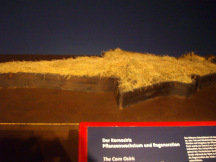
This is an ancient example of the type of Corn Osiris we made. This one is a bit more complicated!
To do this, we needed a sarcophagus of Osiris. I decided to use something that is usually known as a “Corn Osiris.” (I’ve always wanted to try it!) The Egyptians sometimes included these in tombs as symbols of renewing life. They were images of Osiris made of earth and planted with seeds that would sprout even in the darkness of the tomb. The deceased is identified with this “corn” (that is, the grain) and is thus renewed like Osiris.

An overhead view of the same type of Corn Osiris
There seem to have been two types. One was made in the outline of Osiris, filled with earth, and planted.
The other was made of earth, sand, and mud into which were mixed seed, talismanic stones, incenses, and other magical items. This one was often mummy wrapped. In the Khoiak festival of Osiris, such a body of Osiris was created from such a mixture, mummified, mourned over by priestesses as Isis and Nephthys, and interred. His resurrection was proven the next time the priests next entered the tomb for they would have found that the corn had sprouted on the “body” of Osiris.
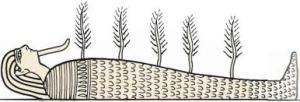
Corn sprouting from the body of Osiris
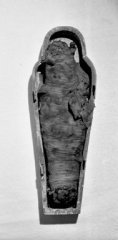
One of the mummy-wrapped type of Corn Osirises
Our ritual at Isis Oasis was in a similar spirit.
What I wanted to show you today is our Corn Osiris. My crafty friend, Philentheos, helped me make it. Here’s what we did:
Using green garden edging, we made a simple mummyform. We cut slits in the bottom of the edging so it could be folded inward and shaped—and so we could staple-gun it to a piece of board. Brass (i.e. “golden”) nails on the outside of the edging helped it maintain the proper shape.
Then we lined it with a plastic garbage bag so it would hold water and filled it with some nice, rich potting soil. On top of that, we added a layer of dirt into which I’d previously mixed grass seed in the hopes of getting a jump on germination. (BTW…I tested chia seeds and grass seed previously, thinking the chia would be quicker. Turns out, at least in October, the northwest blend grass grew better and looked more impressive.) Then we watered it, making it nice and damp.
To make our sarcophagus of the God complete, I made a coffin lid from foamcore. We happened to have some gold foamcore in the garage (yes, we have many strange and magical things in our garage). I painted on the designs, exacto’ed it out, and we had our sarcophagus.
All this was done just one week before my trip to Isis Oasis for the festival. I watched the planted earth anxiously, hoping-hoping-hoping that the seeds would sprout and the grass be obvious enough to make good magic for the ritual. Here’s how it went:

Osiris just after being planted; He needs prettying up and so does our garage.
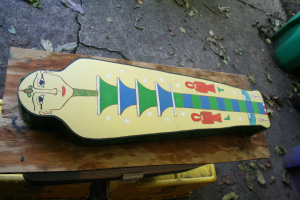
The foamcore sarcophagus lid placed on top of the planted Corn Osiris; that’s the djed pillar in the center flanked by two Knots of Isis, one for Isis, one for Nephthys.
[image error]
Here’s when the “corn” is just starting to sprout.

Here is His progress in the motel room on my way to Isis Oasis; yes, I carried it in and out of the motel…it was COLD at night!

And here He is in His ritual glory…with plenty of green to make the magical point.
After bringing Osiris home, I transferred His charged grass to our lawn, where it is happily growing and drinking in the Pacific Northwest liquid sun.
Filed under: Goddess Isis Tagged: Egyptian magic, Fellowship of Isis, Geyserville California, Goddess Isis, Isis, Isis Magic, Isis Oasis, Khoiak festival, Nephthys, Osiris, Priestess and Priest of Isis








November 2, 2013
Using Kheperu to commune with Isis
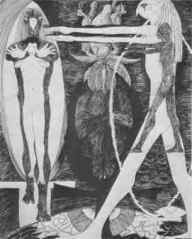
An artistic representation of Kheperu by Steffi Grant; note the human inside the figure of Horus
After last week’s excursion into some Isis hymnlets from the priest Hor, let’s get back to Kheperu, “Forms” or “Transformations.”
This time, I’d like to give you one exercise to try it out for yourself. When properly done, Kheperu puts the priestess or priest in touch with a deeper wisdom that should serve as guide in any act of magic, mundane or spiritual. It means no more—and no less—than placing the Divine part of yourself in contact with a greater Divine power, in this case, Isis. The potential that this offers for spiritual development as well as for practical magic is immense.
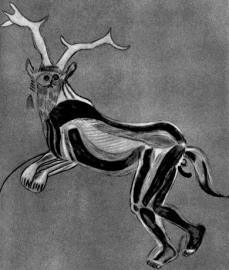
Kheperu has been around for a VERY long time; this is the famous cave painting believed to be a shaman in the Kheper of a stag. The human hands, feet, and face are the clue.
People differ in what they believe a Kheperu or—as it is usually known in modern ceremonial magic—a God/dessform is. Some consider a Kheper to be a purely human psychological construct. Some consider the imaginal form to reflect an archetype, which in turn, reflects a Divine Being or reality. Most will consider the Kheper to be a little of both—a sacred and enlivened image to which both humanity and Divinity contribute.
To me, a true Kheper is an image that interprets the Divine energy of a particular Being or aspect of the Divine to the human being. Normally, it would be an image that has some history behind it, an image that has been invested with human spiritual, mental, and emotional energy for hundreds or even thousands of years. To use Jungian terms, it is an image recorded in the Collective Unconscious. By assuming the Form, we make it conscious rather than unconscious. These images are alive by virtue of the energy, Divine and human, invested in them.
Traveling as Isis
“I am Isis. I have gone forth from my house and my boat is at the mooring rope … O you who travel in the sky, I will row him with you, I will travel as Isis.” (Coffin Texts)
Like the ancient Egyptian who “travel as Isis” and so became Isis, we, as modern priestesses and priests, can also put on the image of the Goddess and become Isis. The invocation of Isis by Kheperu becomes a great, sacred cycle of inflowing and outflowing energy, from human to Divine, Divine to human. If we succeed in doing this, we will certainly know it—for the feeling is very unlike any normal state of consciousness. We may feel as if our body, soul, mind, and spirit are tapped into a stream of energy coming from outside herself, a stream which extends beyond the physical and touches invisible realms. We may perceive the self as enormous, towering over the earth or suspended in space.
[image error]
Actors do a form of the technique when they “become” their character. Masks help, too.
We may have a feeling of expansion in the heart or little rushes or spasms of energy throughout the body. We will feel the presence of Isis and may participate in the creative and magical energy that is a part of Her nature. Through the image of Isis—perhaps seen as the image of our own Higher Self wearing the wings and throne headdress of the Goddess—we will be able to use some of the power of the Goddess Herself to initiate, empower a rite, charge a talisman, or commune with the Goddess.
We will also discover that true Divine contact, though very powerful, is humbling and does not idly flatter the ego. We may come to believe, as did the theurgists and Hermeticists of old, that the Divine Ones participate in our assumption of Their Forms not merely because of Their harmony with the images, symbols, and names employed, but because of Their Goodness and Divine Love for us. We will see that when we expend our effort to reach out the Them, They will in turn stretch out Their hands to us, guiding us, assisting us in our magic, and most importantly, helping us grow spiritually.
This small rite of Becoming Isis is from Isis Magic and visualizes Isis in Her role as Lady of Heaven, Earth, and the Underworld.
Becoming Isis
Enter the temple and face east. Still yourself by breathing the sequence of the Breath of Isis until you are calm and focused. Perform the Four Pillars of the Earth, the Star of Isis, or the Opening of the Ways to open the temple. At the midpoint, begin your invocation:
Priest/ess: I invoke Isis, the Giver of Life, Who pours out the Inundation, She Who makes green plants grow and all people live. I call upon Isis the Ever-Living, Who offers Her abundance to all the souls of earth. I ask Thee, Isis, Lady of Heaven, Lady of Earth, Lady of the Otherworld, to come. O Lady of All Who brought all things into existence through what Her heart conceived and what Her hands created, come to Thy child. Come, Thou Who art the Living Soul of Everything, come to this, Thy temple, and to this, Thy Priest/ess. Let me take on Thy Kheper, Thy Form, Thou Goddess, Isis the Great. Let me be Thy garment.
(Vibrating) ISIS! ISIS! ISIS!
Be seated in a comfortable, meditative posture and closes your eyes. Visualize the form of Isis as described in the speech that follows this explanation. Imagine the Goddess as very large, with Her feet in the Underworld and Her head in the Heavens. Next, visualize yourself growing larger and larger. Notice how your perceptions of the world change as you grow. When you are almost, but not quite, the same size as Isis, turn to face Isis and look into Her eyes—if you can. Bow in respect, then turn so that the image of the Goddess is once again behind you.
Now, imagine stepping backward into the ethereal Kheper of Isis. The face of Isis is before your face. The wings of Isis are upon your arms. The heart of Isis surrounds your heart. The body of Isis envelops your body. The feet of Isis uphold your feet. Through an act of will, now let yourself expand to completely fill the Kheper of Isis.
Priest/ess: (Speaking in the Kheper of Isis, as Isis) As Isis, my form is that of a beautiful woman with shining Wings. I am crowned with the Crescent of the Moon and the Disk of the Sun, and above them rises a Star that rests upon the image of My Throne, for I am Queen of Heaven. In my right hand I bear the Lotus Wand with which I enliven all of nature. In my left, I bear the Ankh, for I am the Mother of Life and the Lady of Re-birth. Light pours forth from My form.
I am the Great Goddess. I am called Isis the Divine and Lady of Words of Power. I am Isis the Magician. I am the Movement Around the Still Point. I am the Form and I am the Ritual. I am the Shaper of the Forces. I am the Goddess Throne, Maker of Kings and the Seat of All Being. Through knowledge of Me my priestesses and priests learn to guide themselves with Wisdom.
I am the Light-giver of All. I am Isis.
Allow as much time as you desire to experience the energy of Isis. You may receive a greater understanding of the nature of Isis. You may see visions from the point of view of the Goddess. You may hear the words of the Goddess in your mind. All these things are experiences of the energy of Isis. When the experience is complete, end the vision by thanking Isis.
When you are ready, take off the Kheper of Isis by reversing the procedure for taking on the Form. Visualize yourself growing smaller so that you no longer fill the image of Isis. Step forward out of the Form, feeling your separation from the image of the Goddess. When you have separated, turn to face the Goddess and bow in respect. Then allow yourself to continue becoming smaller until you return to your human size. Become aware of your human size, shape, and the feeling of your own human energy. Open your eyes and come back to yourself.
Priest/ess: I thank Thee, Isis, the Giver of Life, Who pours out the Inundation. Isis, Who is the Living Soul of Everything. I thank Thee for allowing me to take on Thy Kheper, Lady. I thank Thee for letting me be Thy garment and for receiving this glimpse of Thy Divinity. Guide me ever by Thy hand.
Be in Peace, Goddess. Amma, Iset.
Close the rite in the manner appropriate for the opening, then quit the temple.
I hope you will share with me your experiences with Isis. Be blessed beneath Her wings.
Filed under: Goddess Isis Tagged: Ancient Egypt, Assumption of Godform, Coffin Text, Deity, Divine, Egyptian magic, Goddess, Goddess Isis, Isis, Isis Magic, Queen of Heaven








October 25, 2013
A new (to me) ancient Isis hymn
I’m taking a break from our recent discussion of Kheperu to copy out for you an ancient, but new to me, Isis hymn. I was so excited when I found it! It is indeed rare that I find something on Isis I haven’t seen before, so it’s always a thrill when I do.
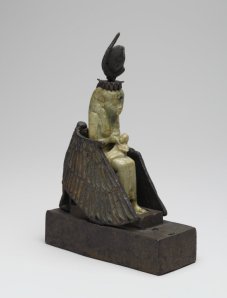
An unusual statue of Isis nursing Horus, but instead of Her wings protecting Osiris or Horus, Isis Herself is protected by the wings of Mut, the Mother Goddess in the form of a vulture. This is from Saqqara.
This is from a group of texts known as The Archive of Hor. Hor was a priest of Isis and Thoth who hailed from the town of Sebennytos, next door neighbor of Isiopolis. At the time of writing these texts, which include recordings of some of his dreams and work in the temples, Hor lived in Memphis. He must have been pretty high up in the temple hierarchy for he sometimes reports his dreams to the Ptolemaic rulers of the period via the Serapeum in Alexandria.
The texts are in Greek and Demotic and written on ostraca, pottery shards. What? No papyrus? Apparently not. But at least pottery is more durable…and so we have these records. They were found at Saqqara, which was used as the necropolis of Memphis.
Hor often describes himself as, “a man of the town of Isis (Temenesi),” aka Isiopolis or Iseion. He calls Her “Lady of the Cavern, the Great Goddess in the nome of Sebennytos.” It seems the Town of Isis is his hometown and that he has a long-standing relationship with Isis. He regularly dreams of Her and receives information in dream from Her as well as from Thoth. He is especially clear that Isis protects the Ptolemies.
With that little bit of background, here are Hor’s hymns or hymnlets (for they seem to be bits and pieces of a hymn that Hor, or perhaps others of the priesthood, could assemble into a full prayer to the Goddess) to Isis:
Come to me Tana, Lady of the Vault, the Lady of the Uraeus, the Lady of the Two Lands, Isis the Great One, Divine Mother, the Great Goddess of the Wady of the Lake, Lady of the Hand of Horus which Osiris gave to Him in Siut.
—written by Hor in Year 12, Pharmuthi, day 17.
[image error]“Come to me, my Tana.” Wait! Could it be tana leaves?!? Sorry. I have a singularly soft spot for this movie. Here, Ankhesenamun invokes Isis for aid.
Come to me my Tana, Isis, into my presence, together with Thy progenitor [Thoth in this mythology], Isis the Great One, Divine Mother, the Great Goddess of the entire land.
Come to me Isis the Great One, Divine Mother the Great Goddess, Lady of Love, the Uraeus Goddess, the Fate.
—an alternative, written by Hor in Pi-Thoth
Come to me Isis, Tana, Lady of Heaven and Earth, Lady of the Tomb.
—an alternative: this is an auspicious beginning. Written by Hor in Buto
Come to me Isis: Thy praise is among men, Thy glory among the Gods, for Thou forever givest sustenance to man for his days of life and when he dies, Thou it is Who performest burial. For Isis has said to me, “They are for you yourself, the two benefits: your sustenance is established concerning you for your days of life, and when you die, I shall cause you to be buried.”
Come to me my Tana, Isis, Queen of All Eternity, Who wears the diadem in the entire land.
—written by Hor in Pi-Thoth
Come to me my Tana, Isis the Lady of the Bundle Which is Bound, and She gives libations in Her turn.
—written in the above town
Now I know you’re asking, “what is this Tana?” Unfortunately, no one knows. The scholars who studied Hor’s Archive have no clue. It seems an intimacy, an endearment. And so I have decided to treat it as a secret name of Isis for those who know Her well. “Come to me, my Tana…”
The rest of the hymn or partial hymns are pretty standard. But that…that…Tana. That I like it very much.
Filed under: Goddess Isis Tagged: Goddess Isis, hymn to isis, Invocation of Isis, Isis, Isis Magic, Saqqara, Sebennytos, Serapeum, Thoth








October 14, 2013
Egyptian Kheperu Magic everywhere
I’ve been off galavanting around at the Fellowship of Isis Convocation at the lovely Isis Oasis in Geyserville, CA. More on that in another post…but for now, let’s continue on with our discussion of Kheperu or Transformations.
Today I’d like to offer some more examples of the technique at other points in history.
We’ve seen how it appears in ancient Egypt—especially in the funerary texts, but remember, those texts were not solely for the dead. There are quite a number of the texts that specifically say that they are good for the living as well. Thus the magical technique of Kheperu isn’t just for the dead; it also benefits the living.
Now let’s follow Kheperu into other cultures. The first place we’ll look is in the Greek Magical Papyri. While these texts were written in Greek, they employ largely Egyptian magical techniques and the scholars who have studied them go so far as to say that the Greek magic can’t be explain except by Egyptian antecedents.
Kheperu in the Greek Magical Papyri
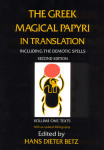
The font of magical papyri translations
In this example, from a text often called the Mithras Liturgy, is a working for Divine communion and a holy vision of Mithras-Helios-Aion. It offers a striking example of how Kheperu was used. In the text, the ritualist acknowledges that it is impossible for a mere mortal to do the things he wishes to do. Therefore, he becomes the God and, no longer a mere mortal, he confidently asks to be received among the Deities:
. . . for today I am about to behold, with immortal eyes—I, born mortal from mortal womb, but transformed by tremendous power and an incorruptible right hand and with immortal spirit, the immortal Aion and master of the fiery diadems—I, sanctified through holy consecrations—while there subsists within me, holy, for a short time, my human soul-might, which I will again receive after the present bitter and relentless necessity which is pressing down upon me . . . Since it is impossible for me, born mortal, to rise with the golden brightnesses of the immortal brilliance, OEY AEO EYA EOE YAE OIAE, stand, O perishable nature of mortals, and at once receive me safe and sound after the inexorable and pressing need. For I am the son PSYCHON DEMOU PROCHO PROA, I am MACHARPH [. . .] N MOU PROPSYCHON PROE. (PGM V 475-829 )
As the working continues, the magician draws in “breath from the rays” and he feels himself being lifted into the air. Eventually, he finds himself among the Gods and declares “I am a star wandering about with you, and shining forth out the deep. . .” Like the Egyptian who after death is “joined to his star,” the magician in this text is also a star, a God in the company of Gods. As the vision continues, he sees many Deities and spirits.
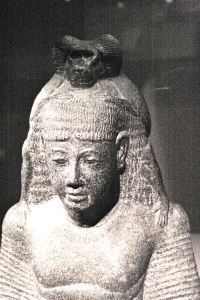
A scribe in the Kheper of Thoth (note the baboon of Thoth on his head)
As grandiose as the Mithras Liturgy is, there are many other examples, too, such as this one in which the intimacy between the magician and the God she invokes is simple and beautiful:
For you are I and I am you, your name is mine and mine is yours. For I am your image [. . . ] I know you, Hermes, and you know me. I am you and you are I.
Kheperu in Theurgy
There is a text called On the Mysteries of the Egyptians, Chaldeans, and Assyrians which is attributed to Iamblichus, a highly influential Syrian Neoplatonist mage living in Egypt around 300 CE. On the Mysteries specifically addresses Kheperu, that is the “Form of the Gods”:
In all of theurgy, the magician maintains a dual aspect: one as a human, which keeps our natural place in the Universe; the other is supported by divine signs because it is connected with the Higher Powers; under their direction it moves harmoniously, and is indeed able to assume the Form of the Gods. In accordance with this distinction, the magician naturally invokes as Higher Beings the Powers of the Universe, since he who invokes them is human; yet he also commands these Powers, since by his arcane formulae he has assumed the sacred Form of the Gods.
Kheperu in Early Christianity
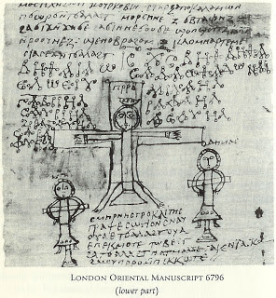
A Christian magical papyrus
Kheperu is also found in early Christian texts. The majority of these texts are Coptic Christian texts from Egypt. It is no surprise that Egyptians were not about to give up this powerful, traditional method of connecting with the Divine just because the Deities now had different names. They merely made some adjustments.
This example is a prayer labeled as the prayer Jesus Christ uttered upon the cross and which the magician too now utters:
I am Jesus Christ. I took to myself a chalice of water in my hand and gave an invocation over it in the name of Marmaroi, the force standing before the father, the great power of Barbaraoth, the right forearm of Baraba, the cloud of light standing before Yao Sabaoth. So I poured by chalice of water down into the sea, and it divided in the middle. I looked down and saw a unicorn lying on a golden field, that is named Sappathai.
And here’s one for Mary:
Reach out and listen to us today, Sabaoth. For I am Mary, who is hidden in the appearance of Mariam. I am the mother who has given birth to the true light.
Problems with Kheperu
With the institutionalization of Christianity throughout the Mediterranean and into Europe, the use of Kheperu in magic declines further. This is because, under the Christian Empire, there were at least three major problems with using the technique: the God problem, the form problem, and the magic problem.
The God problem is obvious. Since there was now supposed to be only one God (what about that Trinity thing?), all the other Gods—the Deities Whose names filled the traditional magical books—must be demons and devils. It was bad enough to speak Their names during an invocation, but it was worse still to claim to BE one of Them.
Magicians found it relatively easy to avoid these problems by using the theologically and politically acceptable Divine names. (Some papyri-type spells were secretly retained, of course, and the Deities turned into demons. We can find their rather pitiful remains in some of the Medieval grimoires.) Yet as time passed, most Western magicians were Christian themselves and naturally applied their own religion to their magic. To avoid claiming to be God, they could use less-direct types of Divine contact, such as quoting the Deities rather than explicitly claiming to BE Them, to empower their workings.
The form problem is a little more interesting. It concerns sacred images and the question of idolatry. Two of the great radical monotheisms, Judaism and Islam, specifically forbade the making of Divine images. The God of the Jews condemned the making of graven images and was not to be represented Himself. Islam too allowed no representation of its God. Catholic Christians found themselves in an interesting position, for while their churches and cathedrals were full of exquisitely beautiful Divine images, they still had to deal with the prohibition against idolatry—idol worship. Originally, this was directed against the use of Pagan sacred images. Because Pagans liberally employed sacred images in their worship, early Christian propagandists were able to redefine any Pagan worship as idol worship.
Then there was the considerable problem with magic itself. Like ‘idolatrous’ Pagan worship, magic employs images—lots of them. Symbolic images of the Deities reveal Their attributes. Talismanic images correspond to Divine energies and retain the energy invoked into them. Astrological images fill the literature. And envisioning or reading texts describing Divine images are used extensively in Kheperu. Paganism, idolatry, and magic shared the same heretical bed and were duly persecuted together.
Given all this, it is not hard to understand why the magical technique of Kheperu fell out of use and began to be lost.

Nuff said 
But not entirely. One interesting place it survived was in exorcism, where the priest tells the indwelling demon: “It is not I who command you, nor my sins, O most unclean spirit, but the immaculate lamb, Jesus Christ Our Lord, the Son of God, commands you.” It survived in Renaissance magic. It survived in early Qabalah. It survived among some Christian mystics. And it survived in occultism. It was vital in the Work of early magical lodges and came into some forms of Wicca as Drawing Down the Moon (as we saw a couple posts ago) and from there into a more generalized Neo-Paganism. There are a lot more details to this history of Kheperu than I can provide here…but this gives you the bare bones of it.
Next time we’ll see how to use Kheperu in further developing our relationship with Isis.
Filed under: Goddess Isis Tagged: Deities, Egypt, Egyptian, Egyptian magic, God, Greek Magical Papyri, Isis Magic, Kheperu, Mithras Liturgy













